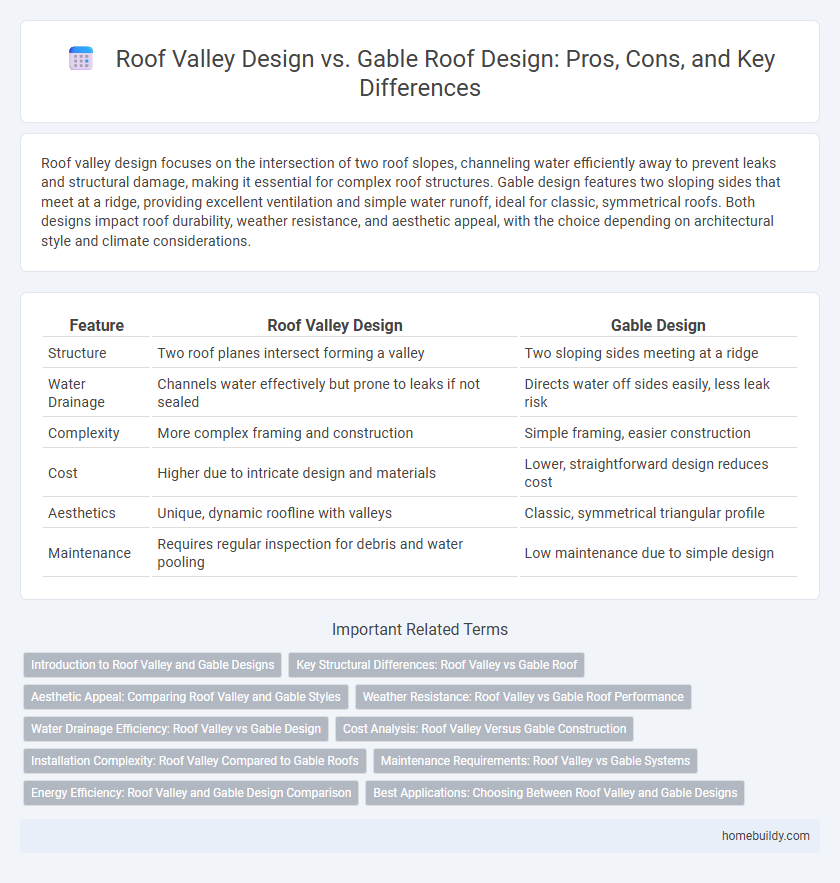Roof valley design focuses on the intersection of two roof slopes, channeling water efficiently away to prevent leaks and structural damage, making it essential for complex roof structures. Gable design features two sloping sides that meet at a ridge, providing excellent ventilation and simple water runoff, ideal for classic, symmetrical roofs. Both designs impact roof durability, weather resistance, and aesthetic appeal, with the choice depending on architectural style and climate considerations.
Table of Comparison
| Feature | Roof Valley Design | Gable Design |
|---|---|---|
| Structure | Two roof planes intersect forming a valley | Two sloping sides meeting at a ridge |
| Water Drainage | Channels water effectively but prone to leaks if not sealed | Directs water off sides easily, less leak risk |
| Complexity | More complex framing and construction | Simple framing, easier construction |
| Cost | Higher due to intricate design and materials | Lower, straightforward design reduces cost |
| Aesthetics | Unique, dynamic roofline with valleys | Classic, symmetrical triangular profile |
| Maintenance | Requires regular inspection for debris and water pooling | Low maintenance due to simple design |
Introduction to Roof Valley and Gable Designs
Roof valleys are critical junctions in roofing where two sloping surfaces meet, channeling water efficiently to prevent leaks and structural damage. In contrast, gable designs feature two opposing roof planes that create a triangular peak, emphasizing simplicity and effective water runoff. Understanding the structural and water management differences between roof valleys and gable designs is essential for optimal architectural performance.
Key Structural Differences: Roof Valley vs Gable Roof
Roof valley design features intersecting roof planes creating internal angles where water channels converge, requiring robust flashing and waterproofing to prevent leaks. Gable roofs consist of two sloping planes meeting at a central ridge without internal valleys, resulting in simpler load distribution and easier construction. Structurally, roof valleys demand reinforced support at the junctions to handle concentrated water flow and snow accumulation, whereas gable roofs rely on straightforward triangular framing for stability.
Aesthetic Appeal: Comparing Roof Valley and Gable Styles
Roof valley designs create complex, intersecting planes that enhance visual interest and provide a sophisticated architectural profile, contrasting with the clean, symmetrical lines typical of gable roofs. Gable roofs offer a classic, streamlined appearance that suits traditional and modern aesthetics, emphasizing simplicity and balance. The intricate geometry of roof valleys appeals to those seeking a dynamic facade, while gable roofs attract homeowners prioritizing timeless elegance and ease of maintenance.
Weather Resistance: Roof Valley vs Gable Roof Performance
Roof valley designs create natural channels that can efficiently direct water runoff, but they are more susceptible to leaks if not properly sealed and maintained compared to gable roofs, which have a simpler, sloped design that allows for quicker water shedding. Gable roofs generally offer superior weather resistance due to their straightforward pitch, reducing the risk of water pooling and ice dam formation common in roof valleys. Proper flashing and quality materials are critical in roof valley construction to enhance durability against heavy rain and snow compared to the inherently robust gable design.
Water Drainage Efficiency: Roof Valley vs Gable Design
Roof valley design channels water into a central trough, enhancing water drainage efficiency by directing runoff away from the roof surface. In contrast, gable design relies on sloped planes that may cause water to accumulate at the base, increasing the risk of leakage or erosion. Effective roof valley construction reduces water pooling and improves overall roof longevity compared to traditional gable designs.
Cost Analysis: Roof Valley Versus Gable Construction
Roof valley construction typically incurs higher costs due to the complexity of intersecting roof planes, increased labor requirements, and additional materials such as valley flashing and waterproofing. Gable roof design offers a more cost-effective solution with simpler framing and reduced material needs, resulting in lower installation expenses. Despite the initial higher investment, roof valleys provide enhanced water drainage and unique architectural appeal that may justify the extra cost in specific projects.
Installation Complexity: Roof Valley Compared to Gable Roofs
Roof valley design involves complex intersections where two roof planes meet, requiring precise flashing and waterproofing techniques to prevent leaks. Gable roofs feature simpler, straight slopes that simplify installation and reduce labor time. The intricacy of roof valleys often leads to higher installation costs and potential challenges in ensuring long-term durability compared to the straightforward gable roof construction.
Maintenance Requirements: Roof Valley vs Gable Systems
Roof valley designs require more frequent maintenance due to the accumulation of debris and water runoff converging at the valley, increasing the risk of leaks and structural damage. In contrast, gable roof systems typically have simpler water drainage paths, reducing the likelihood of water pooling and easing upkeep tasks. Regular inspection and cleaning of roof valleys are essential to prevent clogs and extend the roof's lifespan compared to the lower maintenance demands of gable configurations.
Energy Efficiency: Roof Valley and Gable Design Comparison
Roof valley designs often create more complex structures that can lead to increased heat loss and potential air leakage compared to simpler gable designs, impacting overall energy efficiency. Gable roofs promote better insulation and ventilation due to their straightforward design, which helps maintain consistent interior temperatures and reduce energy consumption. Optimizing roof valley insulation and sealing is crucial to mitigate thermal bridging and enhance energy performance in such designs.
Best Applications: Choosing Between Roof Valley and Gable Designs
Roof valley designs are ideal for complex roof structures where multiple slopes intersect, efficiently channeling water and enhancing architectural interest, making them suitable for multi-dimensional homes. Gable roofs offer simplicity, superior ventilation, and ease of construction, best suited for regions with heavy snowfall or strong winds due to their steep pitch. Choosing between roof valley and gable designs depends on factors like climate, aesthetic preference, and structural complexity, with roof valleys excelling in intricate layouts and gables preferred for straightforward, resilient roofing.
Roof valley design vs Gable design Infographic

 homebuildy.com
homebuildy.com